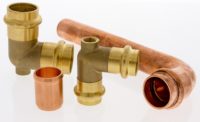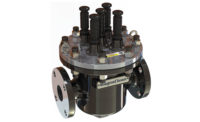Earlier this year, the East Hartford (Conn.) School Department expressed concern to Manchester, Conn.-based Action Air Systems about the inefficient and temperamental hydronic heating system at Barnes Elementary School.
The system was more than 50 years old and consisted of the original pipework as well as newer building improvements. In addition, chemicals had loosened up the scale on the inside of the pipes and there was not an effective method of extraction put in place for the system, which struggled to effectively work.
“The schools’ system was failing to circulate heat and hot water to maximum efficiency,” says Jason Bessette, outside salesman with Emerson Swan’s Engineered Products Division.
It was decided that a Fernox TF1 Delta Filter was the right solution to the school’s problems. “We felt it would help to stop pump failures, unclog the blocked coils and pipework, and provide long-term protection to the system components,” Bessette states. “We met with the mechanical contractors at Action Air Systems on-site in March. They helped demonstrate to the East Hartford School Department how the filter could reinvigorate all four hydronic heating zones within the school.”
First, Bessette’s team drained water from the system into a bottle to provide a demonstration. The water was dirty and brown, so it withdrew the powerful magnet from the new filter and rubbed it along the bottle, which attracted large metal flakes and fine dust.
“In a few seconds, water in parts of the container turned clear,” Bessette said. “This was evidence enough for the board to make the decision to install the filter.”
The filter was installed on a bypass line with a ball valve located on the main between the filter’s isolating valves, allowing for the flow to be controlled through the device. Initially, the majority of the flow was diverted through the filter to take full advantage of its neodymium magnet and hydrocyclonic action. The results showed 99% of the sediment collected was metallic, which would cause serious internal damage to the system if not extracted.
“We purged the system for about three months in total, and with biweekly blowdowns of the filter and weekly blowdowns of the boiler we were able to get the system remarkably clean,” says Ryan Ulrich, service manager at Action Air Systems. “As it’s designed to be fitted onto a range of varying pipework sizes – horizontally or vertically – the new filter was easy to install. It also was beneficial not having to remove the filter when we needed to physically show just how much debris had been collected.”
The filter also can be set to automatically or manually deaerate the trapped air in the system depending on the system design or preference.
“I was completely in awe to see the sheer amount of debris the filter pulled out of our system,” says Dan Ford, maintenance supervisor at East Hartford School Department. “For us, it was crucial that a hydronic heating system runs without interruption. We can’t afford to turn off the heating for extended periods of time. It was important for work to be swiftly carried out. We’ve been really pleased with the results.”
This article was originally titled “A+ effort” in the November 2015 print edition of PM Engineer.




